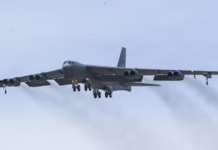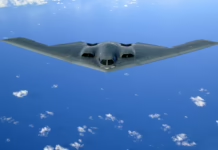Stealth fighter pilot commanded unmanned jet using tablet interface in Nevada demonstration showcasing future of air combat where single pilots control multiple aircraft.
The U.S. Air Force successfully paired an F-22 Raptor stealth fighter with an unmanned combat jet in a demonstration flight in October, marking a major milestone in efforts to have pilots command drone wingmen in future conflicts.
The test took place at the Nevada Test and Training Range, where an F-22 pilot used a tablet interface to control and manage a General Atomics MQ-20 Avenger drone while both aircraft were in flight. The demonstration involved collaboration between F-22 manufacturer Lockheed Martin, General Atomics Aeronautical Systems, and military systems integrator L3Harris.
L3Harris installed Banshee software-defined radio datalinks into both aircraft, enabling real-time communication and control. The F-22 pilot operated the unmanned jet through the fighter’s Government Reference Architecture Compute Environment, known as GRACE, an open architecture system that allows integration of third-party software into the jet’s existing electronics.
The pilot used what officials call a “pilot-vehicle interface” tablet to oversee and direct the MQ-20 during the test flight.
“This effort represents Skunk Works bringing its diverse and unique expertise to the table to lead the way, demonstrating the future of air combat, where single-seat aircraft command and control drones with simple and intuitive interfaces in the cockpit,” said OJ Sanchez, general manager of Lockheed Martin’s Skunk Works advanced projects unit, which led the F-22 integration project.
The successful pairing is significant because the Air Force has designated the F-22 as its priority platform for integration with the new generation of semi-autonomous Collaborative Combat Aircraft currently under development.
“F-22 remains the threshold platform for CCA,” the service said in a fighter fleet modernization assessment released in October. “Integration with F-16, F-35A, F-15E, and F-15EX is an emerging consideration.”
The report specified that autonomous tactical jets will be paired with Lockheed Martin’s newer F-35 strike fighter “in the future.”
Prioritizing the F-22 for drone integration aligns with Air Force plans to tailor the first generation of unmanned fighters for air-to-air weapons delivery in support of air superiority missions, the F-22’s primary role.
However, the twin-engine Raptor poses integration challenges. The fighter predates the newer F-35, meaning it has less advanced onboard communications systems. The F-22 also operates within strict sensor and radio emissions parameters designed to minimize the stealthy aircraft’s observability signature.
These factors have historically complicated enabling full communications between the F-22 and other manned aircraft.
By contrast, the F-35 is further along in the technical integration process. The Marine Corps has already successfully teamed F-35Bs with the Kratos XQ-58A Valkyrie unmanned jet for suppression of enemy air defense missions and is wrapping up a test campaign ahead of an expected production order.
The Air Force is currently evaluating two competing designs for its first Collaborative Combat Aircraft. General Atomics is a finalist with its YFQ-42A design, which recently appeared at the Dubai Airshow. The company has at least two flightworthy examples in testing.
Competing against General Atomics is Anduril Industries with its YFQ-44A, which completed its first flight at the end of October with a fully autonomous takeoff and landing.
Both companies are marketing their designs to prospective overseas buyers in Europe and Asia, including establishing arrangements for local production.
The Air Force noted that newer Block 30/35 F-22s are undergoing “extensive modernisation” as part of broader efforts to upgrade the iconic air superiority fighter.

Key Takeaways
- An F-22 Raptor pilot successfully controlled a General Atomics MQ-20 Avenger drone using a tablet interface during an October demonstration at the Nevada Test and Training Range.
- The Air Force designated the F-22 as its priority platform for integration with new Collaborative Combat Aircraft, which will focus on air-to-air combat missions.
- General Atomics and Anduril Industries are competing to supply the first generation of autonomous combat jets, with both companies flight-testing prototypes.
- The F-22 faces integration challenges due to older communications systems and strict emissions parameters, while the Marine Corps has already successfully paired F-35s with unmanned jets.







